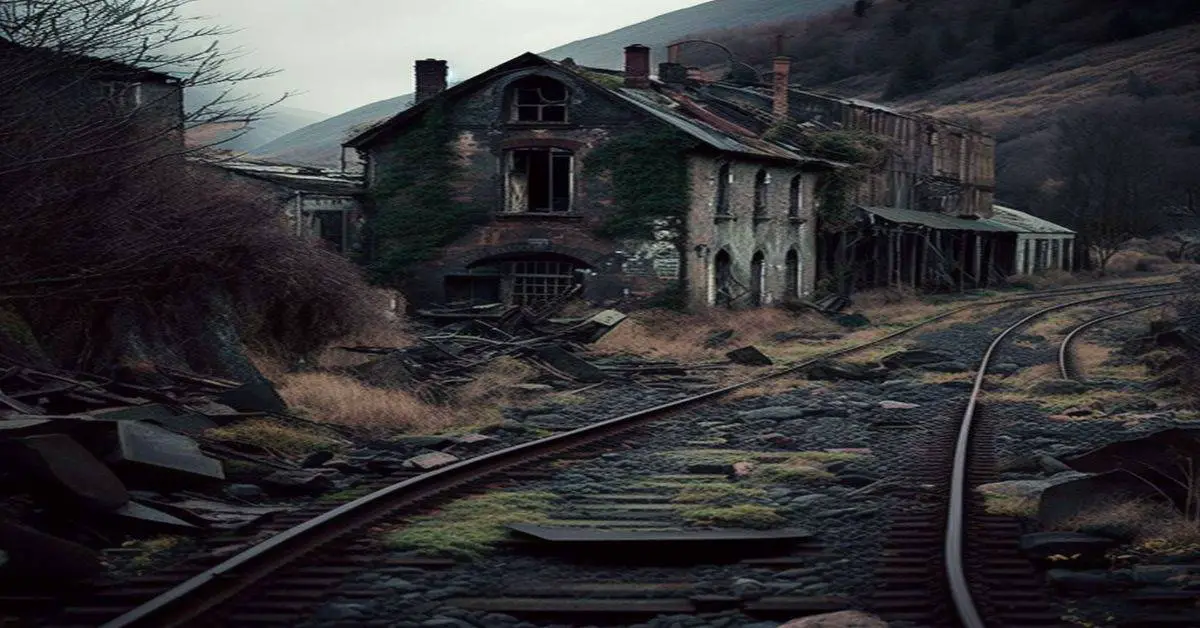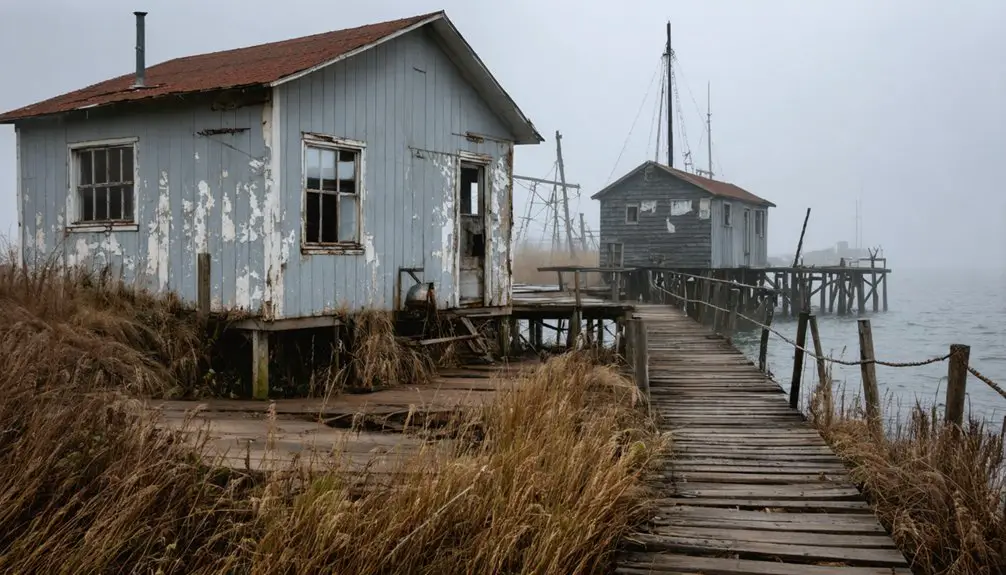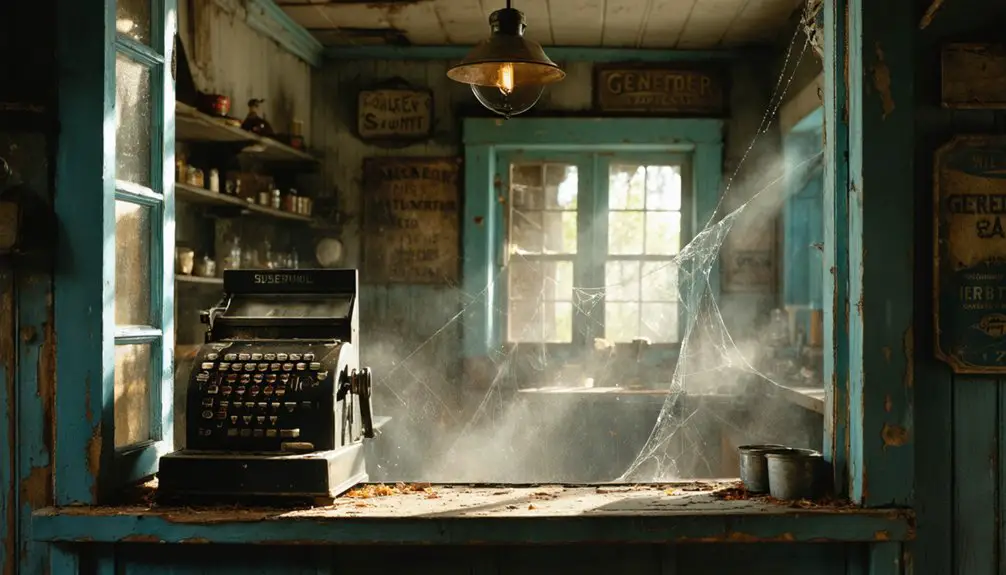You’ll discover Dover, Wisconsin’s fascinating transformation from a British temperance movement experiment to a ghost town. Founded in 1842 by 700 British settlers seeking an alcohol-free community, Dover thrived until the Chicago, Milwaukee & St. Paul Railroad bypassed it for Mazomanie in the 1860s. By 1870, families had dismantled and relocated their homes, leaving only a fenced cemetery as a reminder of this once-bustling frontier town. The site’s rich history holds countless untold stories beneath its silent fields.
Key Takeaways
- Dover was founded in 1842 by British temperance settlers but became a ghost town by 1870 after being bypassed by railroad development.
- The town completely emptied when residents relocated to nearby Mazomanie, physically moving their homes and businesses for economic survival.
- Only a fenced cemetery remains today as evidence of Dover’s existence, containing graves of the original British settlers.
- The town’s demise directly resulted from the Chicago, Milwaukee & St. Paul Railroad’s decision to route through Mazomanie instead.
- Dover transformed from a thriving frontier community with stores, hotels, and blacksmith shops to abandoned land within a single generation.
The British Temperance Movement Connection
While many ghost towns emerged from failed mining ventures or railroad bypasses, Dover’s unique origin stems from the British Temperance Emigration Society‘s ambitious social experiment. Founded in 1842, the society sought to establish alcohol-free communities in America that would showcase their temperance ideology.
You’ll find that Dover represented their most significant effort, with about 700 British settlers relocating to Wisconsin Territory in 1844. Similar to local American groups like the Washingtonian Society, these British settlers viewed sobriety as central to community success.
The society’s vision extended beyond mere prohibition – they wanted to create a model community that would demonstrate the social and moral benefits of temperance living.
More than just banning alcohol, the society dreamed of building an exemplary town that proved temperance could transform society for the better.
The town prospered briefly before experiencing a devastating decline when the Milwaukee Road railroad bypassed Dover in favor of nearby Mazomanie.
However, their idealistic mission soon encountered cultural tensions as Wisconsin’s growing German immigrant population, with its strong beer-drinking traditions, began challenging temperance initiatives throughout the territory.
Early Settlement and Community Growth
The founding of Dover in 1844 marked an ambitious undertaking, as 700 British settlers carved out a new community in the Wisconsin Territory. You’ll find their settlement challenges were numerous, yet they displayed remarkable community resilience as they transformed the wilderness into productive farmland and established essential services.
Within just a few years, you’d have seen a thriving frontier town emerge, complete with general stores, hotels, and blacksmith shops serving the growing population. Members of the British Temperance Emigration Society established this pioneering settlement with high moral principles. Like their counterparts in Dover, Delaware, these settlers left behind twisted family tragedies that still echo through time.
The settlers, primarily of British and Cornish descent, organized their lives around family-centered agriculture and small business ventures. As Wisconsin achieved statehood in 1848, Dover had already developed into a self-sustaining rural community with local governance and the social institutions necessary for frontier life.
Daily Life in 1850s Dover
Living in 1850s Dover meant adapting to frontier conditions through a mix of self-reliance and community cooperation.
You’d find yourself dwelling in a modest home built by family labor, where your daily routine centered around essential tasks for survival. Your pioneer lifestyle involved hunting game, tending to garden crops, and preserving food through smoking or salting. In the early days, pioneers contended with destructive prairie fires that threatened their settlements. The area’s earliest European presence came from French traders who had established routes through the region.
You’d gather with neighbors for communal gatherings in homes or at the local inn, sharing meals on pewter plates and participating in events like house raisings.
Travel meant traversing established trails by horse-drawn vehicle, while commerce depended on the Burlington-Racine route. You’d rely on the local smithy for tool repairs, visit traveling preachers for worship, and turn to home remedies when illness struck, embodying the resourceful spirit that defined frontier life.
The Fateful Railroad Decision
You’ll find that Dover’s fate hinged dramatically on the Chicago, Milwaukee & St. Paul Railroad’s decision to route its main line through Mazomanie instead of establishing a major stop in Dover.
The economic impact was swift and severe, as businesses and families who relied on efficient rail transport for commerce began relocating to better-connected towns. This mirrored the broader decline of rail service that would eventually lead to the Pullman Company ceasing all sleeping car operations by the end of 1968. The Potter Law of 1874 attempted to regulate such railroad operations and prevent unfair practices that could devastate communities.
What you’re seeing in Dover’s abandonment by 1870 represents a classic case of how railroad routing decisions could effectively determine whether a 19th-century Wisconsin settlement would thrive or disappear.
Economic Impact Analysis
While Dover initially flourished as a bustling settlement of 700 British emigrants in 1844, a single crucial decision by Milwaukee Road railroad executives would seal the town’s economic fate.
By bypassing Dover in favor of Mazomanie for their rail depot, they effectively cut off the town’s access to essential transportation infrastructure, triggering a devastating chain reaction.
You can trace Dover’s rapid decline through plummeting property values, vanishing businesses, and mass exodus of residents.
Without rail connectivity, the town couldn’t sustain its agricultural trade or commercial activities. The town had previously supported a thriving business district with a hotel and post office, showing its early economic potential.
The impact proved terminal – by 1870, Dover’s economic sustainability had completely collapsed.
Local families even dismantled and relocated their homes to Mazomanie, leaving behind only gravestones as evidence to the once-thriving community that railroad access might’ve preserved.
Path Not Chosen
The fateful railroad decision that doomed Dover began with a series of strategic meetings by Chicago, Milwaukee & St. Paul Railroad executives.
You can trace the town’s decline to this pivotal moment when they chose to route their main transportation infrastructure through Mazomanie instead. This single decision transformed Dover’s destiny from a potentially thriving hub into a ghost town.
The impact on rural development was swift and irreversible. Without direct rail access, you couldn’t efficiently ship grain or livestock to major markets.
As businesses and settlers gravitated toward rail-connected towns, Dover’s dream of becoming a regional center evaporated. The Potter Law of 1874 attempted to regulate such railroad decisions, but it came too late for Dover.
The town’s classification as a ghost town stands as a stark reminder of how transportation choices shaped America’s rural landscape.
Economic Impact and Mass Exodus

You’d be hard-pressed to find a more dramatic example of railroad-driven decline than Dover’s swift economic collapse, as businesses shuttered and relocated to nearby Mazomanie after the Milwaukee Road chose to bypass the settlement.
The town’s commercial enterprises, including hotels, general stores, and blacksmith shops, couldn’t survive without access to the crucial transportation network that railroads provided in the 1860s.
You can trace the mass exodus through historical records showing how families physically moved their homes to Mazomanie, leaving Dover’s once-bustling streets completely abandoned by 1870.
Today, only the pioneer cemetery remains as a testament to the town’s former existence.
Railroad Drove Business Away
Despite thriving for nearly three decades, Dover’s economic fate changed dramatically when railroad companies chose routes that bypassed the Wisconsin settlement in the late 1860s.
These railroad decisions devastated the town’s commercial viability, cutting it off from essential freight and passenger networks that were revolutionizing American commerce.
You would’ve witnessed the stark economic consequences as businesses, unable to compete with rail-connected towns, saw their revenues plummet.
The impact rippled through every sector – farmers couldn’t efficiently transport goods to market, merchants lost access to affordable freight options, and manufacturers couldn’t receive raw materials cost-effectively.
Without rail access, Dover’s businesses faced transportation costs that made them uncompetitive against neighboring rail towns, where shipping rates were considerably lower and market access was dramatically better.
Family Relocations to Mazomanie
After railroad companies selected Mazomanie as a depot site in the 1850s, Dover’s families began an unprecedented mass relocation that would transform both communities’ destinies.
You’ll find that family dynamics shifted dramatically as entire households uprooted their lives, with many physically moving their homes to Mazomanie. The relocation challenges were offset by promising economic opportunities, as Mazomanie quickly developed modern infrastructure, including a municipal electric utility and industrial facilities powered by Lake Marion.
The mass exodus resulted in Dover’s complete abandonment by 1870, while Mazomanie flourished, growing to over 1,100 residents.
Former clerks, shoemakers, and watchmakers found diverse employment in Mazomanie’s expanding economy, which offered positions in railroad operations, mills, and various skilled trades, fundamentally altering the community’s occupational landscape.
Empty Storefronts and Closure
The Milwaukee Road’s decision to bypass Dover triggered a devastating chain of economic events that would seal the town’s fate.
As trade shifted to neighboring Mazomanie, Dover’s once-bustling commercial district transformed into a stark landscape of empty storefronts and abandoned buildings.
The community decline unfolded rapidly as you would’ve witnessed:
- Essential businesses, including the post office and blacksmith shops, shut their doors permanently.
- Hotels and saloons that served as crucial community gathering spaces ceased operations.
- General stores closed, eliminating access to basic goods and services.
- Commercial buildings fell into disrepair without maintenance or new investment.
The loss of these critical business hubs accelerated Dover’s downward spiral, ultimately leading to complete abandonment by the 1870s.
From Bustling Town to Abandoned Site
Once a thriving settlement of 700 British immigrants, Dover rapidly transformed from a bustling frontier town into an abandoned site within just 25 years.
Dover’s demise began when the Milwaukee Road railroad bypassed the town in favor of nearby Mazomanie, severing crucial transportation links that had sustained the community.
Despite strong community bonds forged among British settlers who’d built a network of hotels, stores, and blacksmith shops, residents couldn’t maintain their livelihoods without railroad access.
You’d have found families relocating en masse to Mazomanie, leaving behind their established businesses and homes.
By 1870, the once-vibrant town stood completely empty.
Today, you’ll find little evidence of Dover’s existence beyond a small cemetery – a stark reminder of how quickly a promising settlement can vanish when cut off from progress.
Historical Legacy and Preservation
Modern preservation efforts tell a bittersweet tale of Dover’s historical legacy. When you visit today, you’ll find minimal physical remnants of this once-thriving British settlement, with only a fenced cemetery marking its historical context.
Unlike other Wisconsin ghost towns that’ve undergone extensive restoration, Dover’s community significance lives on primarily through:
- Historical markers that educate visitors about the town’s British origins
- Local historical writings and online resources documenting its rise and fall
- Cemetery maintenance that preserves the final resting place of early settlers
- The surrounding farmland that tells the story of agricultural heritage
The site’s current status, with no preserved structures and limited public access, reflects the challenges of maintaining historical connections to Wisconsin’s pioneer settlements.
Preserving pioneer history proves challenging when time erases physical traces, leaving only memories and documents to tell the story.
This leaves Dover’s legacy to be told mainly through documentation rather than physical landmarks.
What Remains Today: A Ghost Town’s Footprint
Visiting Dover’s ghost town site today reveals little more than silent fields and a solitary cemetery where a vibrant British settlement once stood.
You’ll find no standing structures, public buildings, or visible foundations from the original town – everything has been reclaimed by farmland and natural vegetation.
The cemetery remains the most tangible connection to Dover’s past, with weathered tombstones offering glimpses into the lives of former residents.
While potential archaeological findings lie beneath the surface, no formal excavations have documented historical artifacts or structural remains.
Modern roads now bypass the original settlement, and you won’t find any historical markers or interpretive signs.
The absence of railroad infrastructure, which was built in nearby Mazomanie instead, helps explain why Dover’s physical footprint has nearly vanished from the landscape.
Frequently Asked Questions
Were There Any Documented Natural Disasters or Epidemics in Dover?
You won’t find any documented natural disasters or epidemic outbreaks in the records. Historical evidence shows the town’s decline was purely economic, triggered by the railroad bypassing the settlement.
What Happened to the Original Town Records and Documents?
You’ll find most original records were lost when families relocated after 1870. Without centralized record preservation, documents scattered or deteriorated, making historical research challenging for those seeking information today.
Did Any Notable Historical Figures Ever Visit Dover?
Like footprints in untouched snow, you won’t find traces of famous visitors in Dover’s brief history. No records exist of any historically significant figures ever stopping in this short-lived settlement.
Were There Any Native American Settlements in the Dover Area?
You’ll find Ho-Chunk tribe settlements dominated this region, with their settlement patterns including seasonal camps, hunting grounds, and permanent villages throughout the area before European colonization displaced them.
What Was the Peak Population of Dover Before Its Decline?
You’ll find the peak growth reached about 700 settlers during the 1844 founding by the British Temperance Emigration Society, before experiencing rapid population decline when the railroad bypassed the settlement in the 1870s.
References
- https://www.frrandp.com/2020/03/a-town-bypassed-dover-wisconsin.html
- https://lakecountrytribune.com/exploring-the-haunting-echoes-of-wisconsins-ghost-towns/
- https://www.hmdb.org/m.asp?m=6780
- https://upnorthnewswi.com/2024/02/21/the-fascinating-stories-behind-7-wisconsin-ghost-towns/
- https://creators.spotify.com/pod/profile/slackstosweatspodcast/episodes/M139-The-Forgotten-Town-of-Dover–Wisconsin-Exploring-Its-Haunted-History-and-Abandonment-e3310q1
- https://wi101.wisc.edu/the-whiskey-war-of-1854/
- https://wi101.wisc.edu/the-temperance-movements-impact-on-wisconsins-early-laws/
- https://emke.uwm.edu/entry/temperance/
- https://archive.org/stream/b29001262_0001/b29001262_0001_djvu.txt
- https://usghostadventures.com/dover-ghost-tour/



